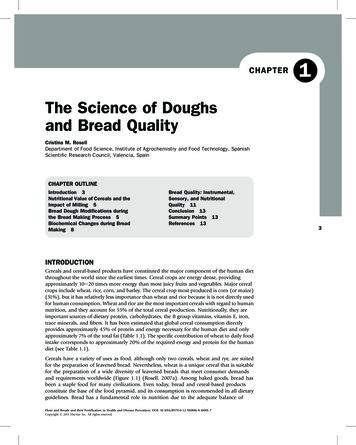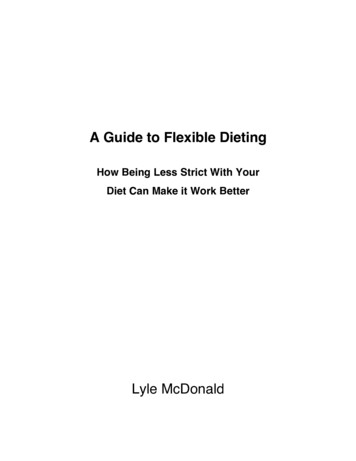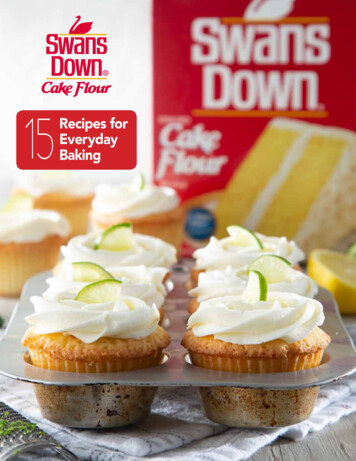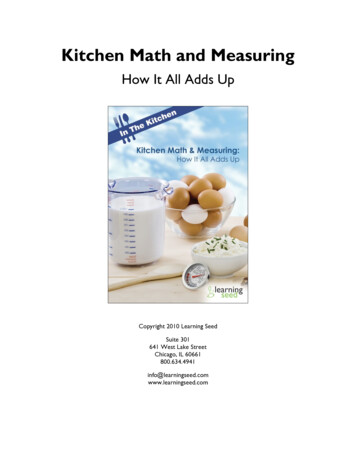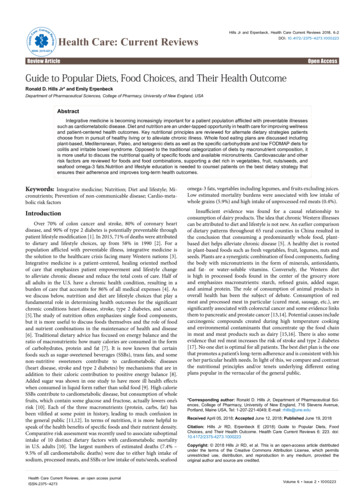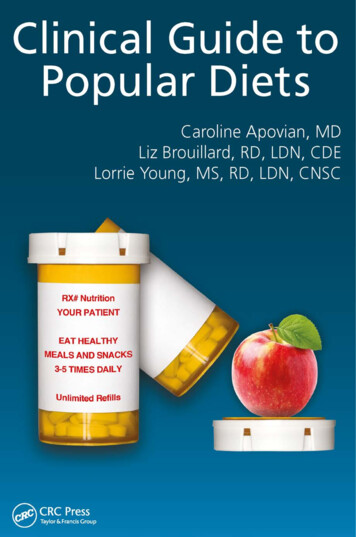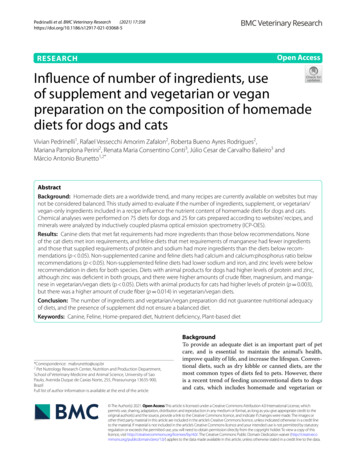
Transcription
26BAKING FOR SPECIAL DIETSAFTER READING THIS CHAPTER, YOU SHOULD BE ABLE TO:1. Describe nutritional concerns associated with baked goods and desserts.2. Describe allergy and food intolerance concerns associated with baked goods and desserts.3. Using a knowledge of ingredient functions, describe how to reduce or eliminate fat, sugar,gluten, dairy products, and eggs in baking formulas.WHAT IS “HEALTHFUL” food? First, of course, the food must not cause harm. Inlight of our increasing awareness of food allergies, certain foods that are perfectlysafe for some people are anything but healthful for those who are allergic to oneor more of their ingredients. Second, to be healthful, a food must contribute toour well-being. It might be argued that even a rich dessert that has no nutritionalvalue and is high in fat and sugar can contribute to our emotional well-beingsimply because it is delicious and satisfying. Most pastry chefs would probablyagree with that statement. However, what we usually mean when we say a food ishealthful is that it is high in nutrients and low in calories from fat and sugar.683Gisslen-c26.indd 6833/22/2016 8:40:42 PM
684C H A P T E R 26 BAKING FOR SPECIAL DIETSIt is sometimes said that bakers are in the “fat business” because the products theymake are high in fat. This is not completely true, or at best it is misleading. Many of themost important products of the bakeshop are low in fat or are fat-free, from Frenchbreads to fruit compotes and meringues. Still, it is true that other products, such aspastries and cookies, are high in fat and low in nutrients other than calories. To addressthis, many pastry chefs today are trying to develop more healthful versions of popularitems. More importantly—because allergic reactions can be fatal—cooks, bakers, andpastry chefs alike are responding to the very real problem posed by food allergies byproducing foods that are both delicious and safe for their customers.NUTRITIONAL CONCERNSDIET AND HEALTH are increasingly in the news. Rising obesity rates are regularly in theheadlines. Increasing numbers of people suffer from food allergies. Health problems caused bydiet are increasing the costs of medical care. Often, it seems, people are too afraid of food toenjoy it. At the same time, our love affair with restaurants and bakeries continues to grow. Peoplewant food they can enjoy and that is also healthful.Dietary concerns can be divided into two broad areas: those about nutrition, and thoseabout food allergies and intolerances. Having good nutrition means consuming a varied dietthat includes essential vitamins, minerals, proteins, and other nutrients. At the same time, itmeans limiting the intake of foods that can be harmful in large quantities. Managing weight gainrequires limiting calories, especially calories from fats and sugar. The term empty calories refersto foods that provide few nutrients per calorie. Foods of high nutrient density are those thathave a high level of nutrients per calorie. Fruits, vegetables, and whole grains are examples offoods with high nutrient density, while refined sugar and flour have low nutrient density.For the customer, choosing nutritious foods is optional. Even people who usually choosenutritious foods can enjoy a rich pastry or choose a piece of white bread over whole grain.Enjoying limited sweets as part of a balanced diet provides enjoyment without necessarily havingill effects. For those with food allergies, however, choosing the right foods can be a matter of lifeor death. Allergic reactions can range from discomfort to severe illness and even death, soaddressing these concerns is of great importance to all food service workers.In this chapter, we approach nutrition concerns and allergies in separate sections becausethey require somewhat different approaches to finding alternatives in the bakeshop. After exploring the main dietary issues, we examine ways to modify formulas for special needs. The chapterconcludes with a selection of formulas that give examples of ways to satisfy special dietary needs.These formulas were developed using the techniques outlined in this chapter.Dietary baking is a large and complex subject, one that encompasses many subtopics, suchas gluten-free baking and baking with sugar substitutes. Many books have been written abouteach of these subtopics, so this chapter is intended to serve only as an introduction to them, tofamiliarize you with the main issues and the general procedures for devising formulas suitable forrestricted diets. Consult the Bibliography (p. 748) for books that delve more deeply into the topicstouched on here. In particular, you will find collections of formulas for many different dietarypurposes.Nutrition in the BakeshopThe role of the baker or pastry chef in preparing nutritious foods varies greatly, depending on thepart of the industry in which he or she works. Food services in schools, hospitals, and nursinghomes must, of course, plan menus to meet basic nutritional needs. A qualified dietitian is usually required in such establishments. On the other hand, retail bakers and restaurant pastry chefshave a primary responsibility to prepare a variety of attractive and flavorful items that will sell.For them, it is often good business to include more healthful preparations among the items theyoffer, but many customers will still prefer chocolate mousse over fruit compote.Gisslen-c26.indd 6843/22/2016 8:40:44 PM
NUTRITIONAL CONCERNSSatisfying nutritional concerns has two aspects: providing desirable nutrients and avoidingundesirable nutrients. A nutrient is a substance that is essential for the functioning or growth ofan organism. For this discussion, we divide nutrients into two categories:1. Nutrients that provide energy: fats, carbohydrates, and proteins. (Note that proteins can beused by the body for energy, but their more important function is to provide the buildingblocks of all cells. See Basic Nutrients Reviewed sidebar.)2. Nutrients that are needed for metabolism, or basic body functioning, including all the chemical processes that take place within cells: vitamins, minerals, and water.A healthful, balanced diet is one that includes all the nutrients in just the right amounts,not too much or too little of any of them. For many people, balancing the diet means consuming foods with more vitamins and minerals—the metabolism nutrients—and less fat andcarbohydrates—the energy nutrients.Increasing Desirable NutrientsIn our culture, foods from the bakeshop form a relatively small part of the normal diet. Thus, wedon’t normally look to these foods—desserts, pastries, and breads—to give us more than a smallpart of our essential nutrients each day.Nevertheless, bakers can take some steps to give customers the option of choosing itemswith more vitamins, minerals, and fiber (see the Fiber sidebar). The most significant sources ofvaluable vitamins and minerals among bakeshop ingredients are whole grains, fruits, and nuts.Bakers have ways of incorporating these ingredients to give customers the option of choosingmore nutritious breads and desserts. For example:685FIBERThe term fiber refers to agroup of complex carbohydrates that can’t be absorbedand used by the body. Thus,fiber supplies no calories ornutrients. However, fiber isimportant for the properfunctioning of the intestinaltract and the elimination ofbody waste. In addition, thereis evidence that sufficientdietary fiber helps preventsome kinds of cancers andhelps lower cholesterol in theblood. Fruits and vegetables,especially raw, and wholegrains supply dietary fiber. Replace part of the white flour in doughs and batters with whole wheat flour. Replacing upto 2 ounces per pound (125 g per kg) usually has only a small effect on dough formation.Replacing more than this can be done, but the bread or other product is likely to beheavier.B A S I C N U T R I E N TS R E V I E W E DCarbohydrates are the body’s most important sources of food energy. These compoundsconsist of long chains of carbon atoms with oxygen and hydrogen atoms attached to the sides.Starches and sugars are the most important dietary carbohydrates.Fats supply energy to the body in highly concentrated form. Also, some fatty acids arenecessary for regulating certain body functions. Third, fats act as carriers of fat-solublevitamins.Proteins are essential for growth, for building body tissue, and for basic body functions.They can also be used for energy if the diet doesn’t contain enough carbohydrates and fats.Vitamins are present in foods in extremely small quantities, but they are essential forregulating body functions. Unlike proteins, fats, and carbohydrates, they supply no energy, butsome of them must be present in order for energy to be utilized in the body. Water-solublevitamins (the B vitamins and vitamin C) are not stored in the body, so they must be consumedevery day. Fat-soluble vitamins (A, D, E, and K) can be stored in the body, but the totalamount eaten over time must be sufficient.Minerals, like vitamins, are also consumed in small quantities and are essential for regulatingcertain body functions. Major minerals include calcium, chloride, magnesium, phosphorus,sulfur, sodium, and potassium. Trace minerals, eaten in even smaller amounts, includechromium, copper, iron, zinc, and iodine. Of all these, sodium, the major mineral in table salt,can contribute to high blood pressure if eaten in large quantities, as it too often is.Water supplies no energy, but the body can’t function without it. The adult human body is50 to 60 percent water by weight.Gisslen-c26.indd 6853/22/2016 8:40:44 PM
686C H A P T E R 26 BAKING FOR SPECIAL DIETS Replace part of the white flour with whole-grain flour from another grain, such as oats, barley, amaranth, buckwheat, soy, or millet, or a grain product such as wheat germ, wheat bran,or oat bran. For yeast breads, you may need to use a wheat flour with higher gluten to compensate for the lack of gluten in these other grains. Add a small amount of flaxseed meal to doughs to provide beneficial fiber and fatty acids. Use flaxseeds, rolled oats, sunflower seeds, and other grains and seeds as toppings forbreads, rolls, and quick breads. Seek out more whole-grain and mixed-grain bread formulas. There are several in this book,and many more are available in bookstores, libraries, and online. Add ground nuts in small quantities to dough formulas, and add chopped nuts to muffinsand pastries. Add raisins and other dried fruits to breads and other baked goods. (See, for example, the FigHazelnut Bread on page 177.) Offer more desserts made with fruits, such as fruit compotes and fruit coulis.Reducing Undesirable NutrientsThe idea of reducing nutrients to be more nutritious may seem a contradiction, but the fact is thatmany people consume far too many energy-producing nutrients in the form of fats, sugars, andstarches. As a result, many people suffer from obesity, heart disease, diabetes, and other ailments related to diet. For the baker, this is a difficult problem to address because these components, especially starches, are the baker’s stock in trade. For the consumer, one of the best waysto cut down on consumption of fats, starches, and sugars is simply to avoid breads and desserts,or at least reduce consumption of them. Nevertheless, the baker can take some measures tomake choices easier for health-conscious consumers. To understand how to approach the problem, a short review of these energy nutrients and issues concerning them is needed.Calories and Weight GainC A LO R I E S A N DK I LO C A LO R I E SIn scientific terminology, theamount of heat needed to raisethe temperature of 1 kilogramof water by 1 C is called akilocalorie, sometimes writtenCalorie (with a capital “C”)and abbreviated kcal. Whenwritten with a small “c,” theterm calorie refers to a unit ofenergy measurement that isonly 1,000th as large—theamount of heat needed to raisethe temperature of 1 gram ofwater by 1 C.Nevertheless, in discussionsof nutrition, the word calorieis commonly substituted forkilocalorie. Just rememberthat when you see calorie inconnection with food, thereal meaning is Calorie(or kilocalorie).Gisslen-c26.indd 686The calorie (or, more correctly, the kilocalorie; see the Calories and Kilocalories sidebar) is a unitof energy measurement. It is defined as the amount of heat needed to raise the temperature of1 kilogram of water by 1 C.The calorie is used to measure how much of the energy the body needs to function is supplied by certain foods. Carbohydrates, proteins, and fats can be used by the body to supplyenergy. 1 gram of carbohydrate supplies 4 calories. 1 gram of protein supplies 4 calories. 1 gram of fat supplies 9 calories.There is a direct connection between calorie intake, physical activity, and weight gain orloss. Simply put, if you consume more calories than you burn, you gain weight. If you consumefewer calories than you burn, you lose weight. All the diet schemes and fashions in the world—atleast those that are medically sound—can be reduced to this. In other words, losing weight is possible only by eating fewer calories, burning more calories through exercise, or both.FatAs the above list shows, fats are a concentrated form of energy, supplying more than twice asmany calories per gram as do carbohydrates and proteins. This suggests that reducing fats in thediet is an effective dietary method of weight loss. Always keep in mind, however, that some fat isnecessary in the diet, both for regulating certain body functions and for carrying fat-solublevitamins.Fats may be classified as saturated, monounsaturated, or polyunsaturated. Saturated fatsare solid at room temperature. Animal products—eggs and dairy products, as well as meats, poultry, and fish—and solid shortenings are the major source of saturated fats. Tropical oils such ascoconut oil and palm kernel oil are also rich in saturated fats. Health experts believe eating highlevels of these fats contribute significantly to heart disease and other health problems.3/22/2016 8:40:44 PM
NUTRITIONAL CONCERNS687Polyunsaturated fats and monounsaturated fats are liquid at room temperature. Althoughconsuming too much of any kind of fat is unhealthy, these fats are considered more healthful thansaturated fats. Polyunsaturated fats are found in vegetable oils such as corn oil, safflower oil,sunflower oil, and cottonseed oil. High levels of monounsaturated fats are found in olive oiland canola oil. Recent research has suggested that monounsaturated fat may actually lower thelevels of the most harmful kinds of cholesterol in the body. Both kinds of unsaturated fats are alsofound in other plant products as well, including whole grains, nuts, and some fruits andvegetables.One group of saturated fats of special concern is trans fats. These fats occur only in smallamounts in nature. Most of the trans fats in our diets come from manufactured fats subjected toa process called hydrogenation. Hydrogenated fats are fats that are changed from liquid to solidby adding hydrogen atoms to the fat molecules. This is the process used to make products suchas solid shortening and margarine. Trans fats are of concern because they limit the body’s abilityto rid itself of cholesterol that builds up on the walls of arteries.Fats are members of a group of compounds called lipids. Another lipid found in the body ischolesterol, a fatty substance that has been closely linked with heart disease because it collectson the walls of arteries and blocks the flow of blood to the heart and other vital organs. It is foundonly in animal products and is especially high in egg yolks, butterfat, and organ meats such asliver and brains. The human body can manufacture its own cholesterol, so not all the cholesterolin the blood is necessarily from foods. Although some cholesterol is necessary for body functions,it is not considered a nutrient because the body is able to manufacture all the cholesterol itneeds. Experts generally agree it is best to keep the cholesterol in the diet as low as possible.Sugars and StarchesSugars are simple carbohydrates. Simple sugars, such as glucose, are small compounds containing 6 carbon atoms. Table sugar, or sucrose, is a larger sugar molecule with 12 carbon atoms.Sugars are found in sweets and, to a lesser extent, in fruits and vegetables.Starches are complex carbohydrates consisting of long chains of simple sugars boundtogether. They are found in such foods as grains, bread, peas and beans, and many vegetablesand fruits.Most authorities believe that complex carbohydrates, especially those from whole grainsand unrefined foods, are better for you than simple carbohydrates. This is partly because starchyfoods also have many other nutrients, while sweets have few other nutrients. Also, there is someevidence that a lot of sugar in the diet may contribute to heart and circulatory diseases. Simplesugars and refined starches are primary sources of empty calories.Many consumers believe that honey, raw sugar, and some other sweeteners are more nutritious than refined white sugar. It is true that these products have some beneficial minerals andother nutrients, but only in tiny amounts. They are still mostly sugar. Substituting one of these forwhite sugar does not reduce the amount of carbohydrate in a formula.SodiumAs explained above, excess sodium in the diet has been linked to high blood pressure, so peoplewith this ailment are generally advised to reduce their sodium intake. Salt is the primary sourceof sodium in the diet. Most of a person’s salt intake, however, does not come from baked goodsand desserts but rather from main courses, side dishes, and salty snacks. For people on salt-freediets, reducing or eliminating salt in desserts and pastries may be advisable, and this can be donewith only a small effect on flavor. For most people, however, this change will have only a smalleffect on their total sodium intake. Be careful, also, when reducing the salt content of yeastbreads, as one of the functions of salt is to regulate yeast activity (see p. 88).Vegetarian DietsA vegetarian diet is one consisting entirely or mostly of foods derived from plants. People followvegetarian diets for a variety of reasons: concerns about nutrition and health, ethical standards,or moral, religious, or cultural beliefs.There are several types of vegetarian diets. The vegan diet is the most restrictive. Itincludes plant products only. All animal products, including dairy and eggs, are off-limits.Gisslen-c26.indd 6873/22/2016 8:40:44 PM
688C H A P T E R 26 BAKING FOR SPECIAL DIETSLacto-vegetarians eat dairy products in addition to plant products, but they will not eat otheranimal products. Ovo-vegetarians eat eggs in addition to plant products. Lacto-ovo-vegetarianseat dairy and egg products as well as plant products.For the baker or pastry chef, the main ingredients of concern to vegetarians are thefollowing: Dairy products, including milk, cream, butter, and cheese, must not be included in productsintended for vegans. They are acceptable for lacto-vegetarians and lacto-ovo-vegetarians. Eggs must not be included in products intended for vegans, although they are permitted forovo-vegetarians and lacto-ovo-vegetarians. Honey should not be used in baked goods and desserts for vegans, because it is an animalproduct. Refined sugar poses problems for vegans. Because some cane sugar is refined with the use ofanimal bone char, many vegans avoid all refined sugar, to be on the safe side. If you canassure the customer that the sugar is made from sugar beets and not refined with bone char,some vegans may be willing to eat it. A safer approach is to substitute a product like datesugar or maple sugar. These products impart a distinctive flavor, however, and are also moreexpensive than refined white sugar. In addition, avoid using any prepared ingredient thatcontains sugar, because you can’t be sure of the source of that sugar. Gelatin is an animal product, so it must be avoided in vegetarian products. Agar-agar,a gelatinlike product made from seaweed, can be substituted (see p. 82).KEY POINTS TO REVIEW What do the terms empty calorie and nutrient density mean, and how are they related? What are the six basic nutrients, and what are their functions? What techniques can be used to add desirable nutrients to baked goods? What nutrients can be reduced to create a more healthy diet? What are the main types of vegetarian diet?FOOD ALLERGIES AND INTOLERANCESAN ALLERGEN IS any substance that triggers an allergic reaction. Many foods, including manyingredients used in the bakeshop, are potential allergens. Health agencies report that more andmore people are being diagnosed with food allergies each year, so this is a growing problemworldwide.A food allergy is an abnormal response to a food triggered by the immune system. In otherwords, the body’s immune system mistakenly believes a food item is harmful and reacts to protect the body. This reaction may include the production of chemicals that are actually harmful tothe body, sometimes even fatal. A sudden, severe, allergic reaction of the immune system iscalled anaphylaxis.The foods that most commonly spur allergic reactions are peanuts, tree nuts, eggs, fish,shellfish, milk, soybeans, and wheat. Note that, with the exception of fish and shellfish, all ofthese products may be found in the bakeshop. Wheat, milk, and eggs are among the baker’s mainingredients.A food allergy is not the same as a food intolerance. A person may develop gas and bloatingafter eating a particular food, but this reaction does not involve the immune system. For example,people with lactose intolerance lack an enzyme that enables them to digest milk sugar, or lactose. These individuals may develop gas and abdominal pain when they consume dairy products.For the purpose of this discussion, we treat allergies and intolerances together because they bothinvolve foods that must be avoided by the affected customer.Gisslen-c26.indd 6883/22/2016 8:40:44 PM
FOOD ALLERGIES AND INTOLERANCES689In food service operations and retail bakeries, precautions must be taken both in thepreparation of food and in service to customers. The following are just a few of the steps youshould take.Food Preparation1. Train staff to be aware of ingredients that can cause allergic reactions.2. Read the ingredient labels on all prepared food items used in the kitchen.3. Don’t make casual or unannounced ingredient substitutions.4. Avoid cross-contamination. For example, a “safe” food could become dangerously allergenicif it is prepared on an inadequately cleaned prep table containing dust from peanuts used inprepping an earlier item. Ideally, set up a separate prep area for preparing foods for allergysufferers.Food Service1. Service and sales personnel should be aware of the ingredients in all menu items and shouldbe prepared to answer questions about ingredients or to consult someone on staff whoknows the answers.2. Be sensitive to customers’ questions; if someone asks whether an ingredient is used, find outif that customer has an allergy. If a customer’s questions cannot be answered with confidence, admit it and be prepared to suggest alternative choices.Among bakeshop ingredients, nuts, gluten, dairy products, soy products, and eggs are theprimary culprits for sufferers of food allergies and intolerances. To this list we add alcohol, whichis not an allergen but which must be completely avoided by some people.NutsPeanuts and tree nuts—such as walnuts, almonds, Brazil nuts, and pecans—are among the mostpotent allergens. They are responsible for many of the 150 to 200 deaths from food allergies eachyear in the United States. (Note: Peanuts are not true nuts but legumes, like peas and beans,so the allergies are somewhat different.) Even trace amounts of these nuts, such as dust frompeanuts left on a work surface, can trigger an allergic reaction. The only safe measure to takeis complete avoidance. It is not enough, for example, to leave the nuts out of a baked item ordessert. The surest way to guarantee a product is nut-free is to make it in a separate prep areausing equipment that is reserved strictly for use in preparing goods that do not contain nuts.Fortunately for the baker or pastry chef, nuts are not critical ingredients in most bakedgoods. Most formulas do not call for nuts, and it is not difficult to eliminate them from those thatdo, or to substitute similar preparations—for example, substitute a plain meringue disk for japonaise (p. 342), or use plain short dough instead of linzer dough (p. 314).GlutenCeliac disease is a genetic (inherited) disorder in which the intestine is unable to process glutenproteins (see the “Celiac Disease” sidebar). Symptoms may be severe, and there is no cure. Theonly remedy is to avoid gluten completely.The difficulty for the baker is that gluten is the backbone ofCELIAC DISEASEbreads and many other baked goods, and is a component of wheatflour, the baker’s main ingredient. In addition, gluten proteins areCeliac (pronounced SEE lee ak) is a disease of the immunefound in rye, barley, spelt, and oats.system, like other food allergies. When gluten is ingested byNevertheless, it is possible to bake a variety of products usingsomeone with this disease, the gluten proteins damage thegluten-free flours, such as rice, millet, buckwheat, amaranth, andlining of the small intestine. As a result, the body is less ablequinoa flours; potato starch, cornstarch, and cornmeal; and floursto absorb other nutrients. The disease has many, and varied,from chickpeas and other legumes. The structure-building propersymptoms—including anemia, fatigue, intestinal pain, andties of gluten proteins must be supplied by other ingredients, suchmalnutrition—making it difficult for doctors to diagnose.as egg proteins and vegetable gums. These ingredients don’t workOnly recently has the scope of the problem become morethe same way as gluten, however, so the texture of the productswidely recognized. There are still probably many people whowill differ. Doughs will be less elastic, and baked items are likely tosuffer from the disease without knowing what it is.be more crumbly than similar items baked with wheat flour.Gisslen-c26.indd 6893/22/2016 8:40:44 PM
690C H A P T E R 26 BAKING FOR SPECIAL DIETSLactose Intolerance and Milk AllergiesLactose, also called milk sugar, is a form of simple sugar found in dairy products. Some peopleare unable to digest lactose, and drinking milk or eating products containing lactose results inintestinal discomfort, gas, bloating, and other symptoms. Because lactose is not an importantcomponent of baked goods, lactose-free milk and other lactose-free dairy products can easily besubstituted in most formulas. Other milk replacers, such as soy milk, can also be used.Milk allergies are immune reactions to milk proteins, rather than to lactose. This allergy isfairly common in infants, but most children grow out of it. The allergy is uncommon in adults.Those who suffer from it must usually avoid all dairy products.SoySoy products contain at least 15 proteins, and it is not clear whether allergic reactions are causedby one or more of these proteins or by other components of soybeans. A great many preparedfoods contain soy products, so it is necessary to read ingredient labels carefully. The emulsifierlecithin, for one, is used in many products, including chocolate, and may not be identified asderived from soybeans. As with lactose, soy products are not essential ingredients in most bakeshop formulas, so avoiding them is relatively easy, as long as bakers are attentive to ingredientlabels.EggsLike milk allergy, egg allergy affects primarily infants and children, and most people outgrow it bythe time they are about five years old. Nevertheless, it does affect some adults, who may reactwith stomach cramps, skin rashes, coughing and wheezing, or, in some cases, severe anaphylaxis(see page 688). The allergic reactions are triggered by one or more of the proteins in the egg.Some people are allergic to egg white proteins, while others have a reaction to the yolks.Because many common egg substitutes are made with egg whites, these products can’t beused as baking ingredients for allergy sufferers. Eggless egg substitutes, on the other hand, contain no egg products. They are made of flour or other starches, plus vegetable gums and stabilizers, and, sometimes, soy protein. They are intended for use in baked goods only—that is, indoughs and batters—and are not suitable for use in custards or breakfast egg preparations.AlcoholUnlike the other food items discussed so far, alcohol is not an allergen, but it must be avoidedby people suffering from the disease alcoholism. Trace quantities of alcohol are present in anumber of products of the bakeshop or pastry department. Alcohol is a byproduct of yeastfermentation and so is present in freshly baked bread, but the amount is so small it doesn’tgenerally pose a problem. By the time the bread cools and is stored, nearly all the alcohol hasevaporated.Small quantities of liqueurs may be used to flavor dessert syrups used to moisten cakes,but here, too, the amount per portion is usually minute. Be prepared to advise customers, however, if a dessert contains significant amounts of alcohol. In some cases, merely the flavor of thealcoholic beverage, even if the alcohol has been burned away, can trigger an undesirablereaction.KEY POINTS TO REVIEW What is the difference between food allergy and food intolerance? What are the most important food allergies and intolerances?Gisslen-c26.indd 6903/22/2016 8:40:44 PM
MODIFYING FORMULAS FOR SPECIAL NEEDS691MODIFYING FORMULAS FOR SPECIAL NEEDSSO FAR IN this chapter we’ve focused on the ingredients or components of baking formulas anddesserts that may have to be modified to accommodate special diets, and why some customersmay need or
Dietary baking is a large and complex subject, one that encompasses many subtopics, such . There are several in this book, and many more are available in bookstores, libraries, and online. Add ground nuts in small quan
